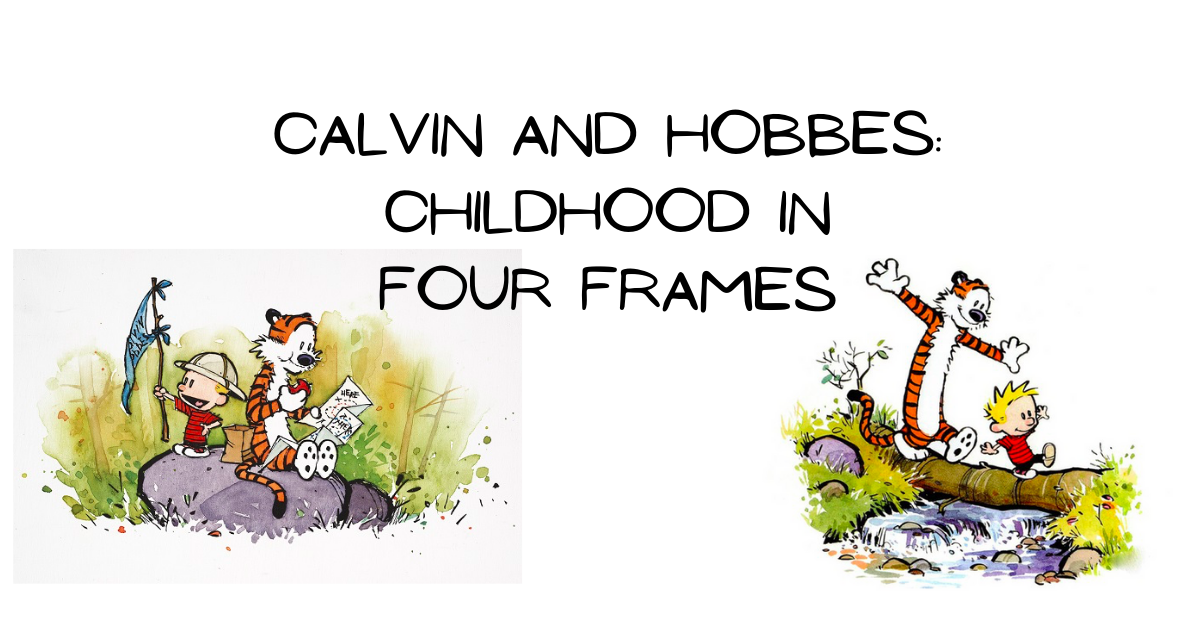Because everyone loves a good story
Calvin and Hobbes: Childhood in Four Frames

Today I shall embark on a deeply academic subject—one so universal that you’ve no doubt given it much thought. It’s so complex that a professor could spend decades dwelling on it, and yet it’s so simple that a child can comprehend it perfectly. It’s primal, sophisticated, imaginative, scientific, and nostalgic. I’m writing, of course, about Calvin and Hobbes.
Fun for All Ages

My husband and I love Calvin and Hobbes. I’ve always kept a couple of the books in my bathroom in case anyone needs a little, er, inspiration. (Is that T.M.I.?) But guess who needs daily inspiration now? My three-year-old son. He requests Calvin every time he’s on the potty. Sure, some of the vocabulary is over his head (intrepid, noxious, gelatinous…that Spaceman Spiff is pretty erudite), but he can still track with the stories just fine.
A little too well, actually. We got him a fuzzy Calvin blanket for Christmas, along with a few more comic books. The blanket shows Calvin and Hobbes pretending, playing, and exploring around a big tree. It’s beautiful. Later I asked my son if he liked the picture on the blanket, and he said, “No, not really. I like Calvin better when he’s being naughty.” Figures.
The Stuff of Childhood
So what makes Calvin and Hobbes one of the most beloved, timeless comic strips? In my opinion, it’s because Bill Watterson’s work captures the essence of childhood a way that everyone can relate to. To begin with, the illustrations are genius. The drawings perfectly depict Calvin’s facial expressions and action shots. Always goofing off, always on the move—a true boy. The illustration style also highlights his daydreams. What Calvin sees in the “real” world is basic compared with the elaborate detail of his imagination.
The content is classic, too. Calvin’s best friend is a stuffed animal, and the girl next door has cooties. He detests his mom’s home cooking and prefers “Chocolate Frosted Sugar Bomb Cereal” with extra sugar on top. He looks forward to Christmas and dreads the start of school. He’s a terror to the babysitter and a mess at home. Basically, he’s a normal, healthy kid.
Trouble at School
Everyone who’s been to school can relate to Calvin’s first-grade experience. You remember the way that time drags on during lectures or the sheer panic that hits you when the teacher calls you out of a daydream. You’re more apt to imagine your desk is a dinosaur than to pass your math quiz. And why did everyone else’s lunch seem so much better than the stuff in your own paper sack?
The school scene is also full of childhood archetypes: long classes, short recesses, lost homework, the harried teacher, the grim principal, and the bully with an overactive pituitary gland. No wonder Calvin disguises himself as Stupendous Man and makes a break for it. Hey, it was worth a shot.

Trouble at Home
Things at home usually aren’t much better for our little red-clad friend. His sadistic mom makes him do homework, play outside, and take baths. She won’t let him eat endless cookies, borrow chainsaws, drive cars, or do anything else remotely interesting. Calvin’s dad is always out to “build Calvin’s character,” which usually amounts to tedious chores or family camping trips gone wrong.
So clearly Calvin’s parents aren’t much comfort. The only friend who understands Calvin is a dangerous but lovable tiger, and even he causes trouble more often than not. Calvin can’t seem to catch a break. Any six-year-old can surely relate, and any sixty-six year old isn’t likely to have forgotten, either. Childhood is a grab bag of magic, misery, and everything in between, and few things capture that truth better than Calvin and Hobbes.
Universal Appeal
And that’s the beauty of Watterson’s comic. No matter who you are, where you were raised, or what’s changed since these comics came out in the mid 1980’s, you’ve got to chuckle at Calvin’s capers. And it’s even better because, while Calvin has to start school again every fall, it’s always first grade. The kid never ages! It’s like reading Peter Pan without the heart-wrenching ending. Really, it’s what we’ve always wanted—to look back on the imaginative parts of childhood with nostalgia and the difficult parts with insight. It’s with good reason that Yoda observes, “Truly wonderful the mind of a child is.” They can be miles deep in imaginative play one moment and then ask you the most baffling philosophical question the next. In this, Calvin is no exception. And that, my friends, is what we’ll be talking about in my next post. See you then!

Awesome subject, Emily! Finally something I can understand!
My husband LOVED Calvin and all his antics. He got all the boys hooked. Now our grandchildren LOVE Calvin! One of my grandsons is 10 and has every single written.
Love the post! So true, Calvin and Hobbes truly encapsulates childhood. It’s an essential bathroom read…